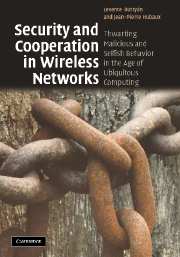 Security and Cooperation in Wireless Networks
Security and Cooperation in Wireless Networks Published online by Cambridge University Press: 05 June 2012
Introduction
Security of information and communication systems is concerned with the prevention or the detection (if prevention is not possible or too costly) of attacks, where an attack is meant to be a deliberate attempt to compromise the system. A system is compromised if it reaches a non-desirable state or it behaves in a non-desirable way, and where the latter can be the result of the former.
A system can also reach a non-desirable state or behave in a non-desirable manner due to some random faults. Random faults, however, are usually less sophisticated than attacks; hence, coping with attacks is more difficult. For instance, a Cyclic Redundancy Code (CRC) can detect random errors in a transmitted message well enough, but it is ineffective in detecting deliberate modifications, because an attacker can compute the correct CRC value for the modified message.
Stealing a password file and cracking passwords off-line is an example of an attack. In this case, the attacker tries to put the system into a non-desirable state where some passwords are known not only to the corresponding legitimate users, but also to the attacker. This allows the attacker to login in the name of a legitimate user and to use the privileges of that user to perform some operations in the system. This then allows the attacker to further compromise the system. For instance, the attacker can modify or delete some important configuration files, which can lead to a non-desirable behavior of the system.
To save this book to your Kindle, first ensure [email protected] is added to your Approved Personal Document E-mail List under your Personal Document Settings on the Manage Your Content and Devices page of your Amazon account. Then enter the ‘name’ part of your Kindle email address below. Find out more about saving to your Kindle.
Note you can select to save to either the @free.kindle.com or @kindle.com variations. ‘@free.kindle.com’ emails are free but can only be saved to your device when it is connected to wi-fi. ‘@kindle.com’ emails can be delivered even when you are not connected to wi-fi, but note that service fees apply.
Find out more about the Kindle Personal Document Service.
To save content items to your account, please confirm that you agree to abide by our usage policies. If this is the first time you use this feature, you will be asked to authorise Cambridge Core to connect with your account. Find out more about saving content to Dropbox.
To save content items to your account, please confirm that you agree to abide by our usage policies. If this is the first time you use this feature, you will be asked to authorise Cambridge Core to connect with your account. Find out more about saving content to Google Drive.